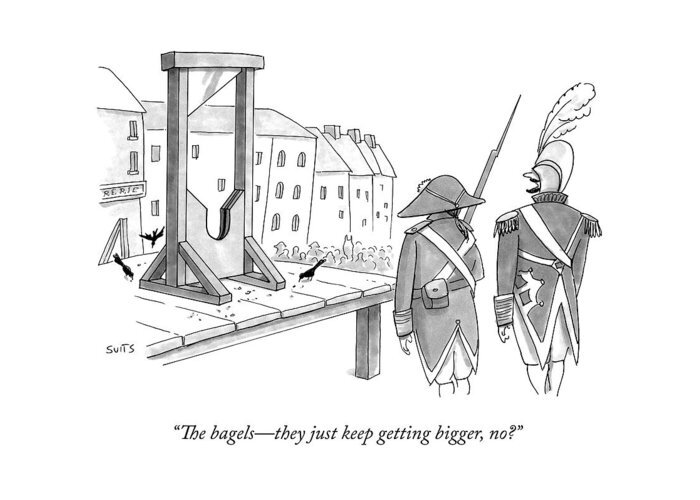
The Guillotine: A Revolutionary Blade
The story behind the infamous chopping block.
by Brian Alcamo
This week, France celebrates le Quatorze Juillet. In the United States, we know this day as Bastille Day. While the actual storming of the Bastille happened two years after the start of the French Revolution, it is one of the movement’s defining moments as it kicked off an era of violence and upheaval that inevitably overturned the French monarchy. The violence and havoc typical of the French Revolution was defined and symbolized by one special device: la guillotine.
Let’s Explore This Hauntingly Iconic Instrument Of Revolution!
If you think capitation by guillotine sounds gruesome, you should know that things used to be much worse. In pre-guillotine 1700s France, people were executed by having their four limbs stretched (and eventually ripped) apart by four oxen that would each run out from the executé’s body. Members of the upper-class could upgrade their execution to a less painful hanging or beheading. Luckily, people eventually caught on to the idea that this style of execution was perhaps a bit much, and in 1789, French physician Doctor Joseph Ignace Guillotin pushed for the invention of a new machine that would behead criminals “painlessly” (yeah, right). Not only did the doctor wish to make persecution less painful, he also wished to make it equal amongst the social classes. The doctor wished for the end of the death penalty entirely, and believed that a standard beheading device done in private could bridge the gap between the rather theatrical and brutal public dismembering and the eventual end of capital punishment.
Despite Doctor Guillotin’s supposedly revolutionary dream of an equal-opportunity beheader, other European countries had already beaten him to the punch (or, chop). In Scotland, a predecessor of the guillotine, known as the Maiden, was in use. but France’s guillotine was the first to be used at the institutional level. Doctor Guillotin worked with German engineer (and harpsichord maker) Thomas Schmidt to build the first guillotine, opting for a diagonal blade as opposed to a round one.
The invention of the guillotine came just in time for the French Revolution. After the storming of the Bastille on July 14th, 1789 (the Revolution’s peak), a new civilian code crafted by the National Assembly was put into place, that equalized the death penalty among France’s social classes. While this isn’t the ideal way for a campaign of equality to start out, it did make the earthly gateway to the Great Equalizer a bit more egalitarian. The first guillotining took place at Place de Greve in Paris on April 25th, 1792 when Nicolas Jacques Pelletier, a highway robber, got the inaugural chop. This kicked off the Reign of Terror, or la Terreur, which was a period of time in which thousands of people were sentenced to death. Despite only lasting about two years, this era is usually what people imagine when they think of the French Revolution. Many notable aristocrats died during this time, with King Louis XVI suffering a blow by the merciless blade on January 21, 1793.
Credit: Julia Suits
Some Revolutionary Vocab for Your French Flashcards:
Un citoyen - a citizen
La monarchie - The monarchy
Un.e paysan.nne - a peasant
Imposition - taxation
La peine capitale - Capital punishment/the death penalty
After the Revolution
After the Revolution, the guillotine remained as France’s capital punishment method of choice. Other European countries such as Greece, Sweden, and Switzerland also continued to use the guillotine, although the device never made much of a splash in the Western Hemisphere. Parisian guillotine sites moved around a bit before ending up in Grand Roquette prison in 1851. In 1870, a man named Leon Berger brought much-needed changes to the machine’s design, adding a spring system, a locking device, and a new release mechanism for the blade. These redesigns set the standard for all new guillotines moving forward.
This was the period of time where a study known as Prunier’s Experiment took place. Researchers had been trying to figure out if the head maintained some level of consciousness after decapitation. Scientists obtained the consent of Monsieur Theotime Prunier in 1879, a death-row sentence, and poked and prodded his head after he was struck by the guillotine. All they could note was that the face maintained an expression of astonishment after the death, but it did not respond to any stimuli.
By 1909, the guillotine was being used behind La Santé Prison. The final execution by guillotine was on September 10th, 1977 in Marseille when murderer Hamida Djandoubi was put to death. While he was the last execution in France, he was not the last to be condemned to execution, with those condemned afterwards being exhumed after the election of François Mitterand in 1981.
The guillotine’s roughly two centuries of notoriety may have come to a close, but its memory lives on as a symbol of what can happen when a thirst for wide-scale violence supersedes enlightened revolutionary thought.
Thanks for Reading!
How do you feel about the French Revolution? Tell us in the comments below, and make sure you share this post with a fellow French-fanatic!



